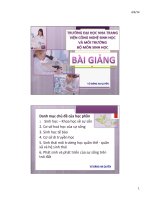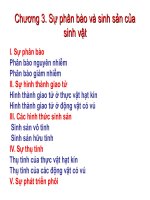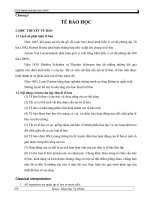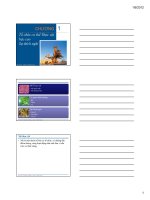bài giảng sinh học đại cương
Bạn đang xem bản rút gọn của tài liệu. Xem và tải ngay bản đầy đủ của tài liệu tại đây (45.26 MB, 269 trang )
!"!"#!$
#$
!"#$%&'#()#*+,-&#
!"#$%&'#()#*+,-&#
./01#234#415#67#45/#184#91:0$
#% &'()$)*+$,$-)./$)*+$01$23$24($
5%$67$28$).9$)*+$+:/$23$24(;$
<%$&'()$)*+$=>$?@.$
!%$67$28$A'$=BCD1($)*+$
E%$&'()$=)9'$FG'$=BHI(;$)*+$JCK($=)L$M$JCK($
NO$0@$)P$2'()$=)9'$
Q%$R)9=$2'()$0@$S)9=$=B'L($+:/$23$24(;$=BT($
=B9'$UV=$
!"!"#!$
5$
!"#$%&'#()#*+,-&#
!"#$%&'#()#*+,-&#
! Là môn khoa học về sự sống
The study of Living Things
! Bio = life (sự sống)
logy = knowledge (môn học)
(study of)$
“SINH HỌC” LÀ GÌ?
(What is BIOLOGY? )
!"!"#!$
<$
!"#$%&'#()#*+,-&#
(;<#=>?&(#(;<@#&(A#B(C#&DE#F#
G#HIJ0#2/0K#L1MN#OP#6QR4#STU2#LV/#OPN#6:I#2WT#XIYT#
184#!#6QR4#ZM2#[P#\#4]L#STU2#LV/#OP#6TU2#^/01#
!"#$%&'#()#*+,-&#
How did organelles develop Infolding –plasma membrane folded into cytoplasm
In eukaryotic cells? Endosymbiosis – one organism became
incorporated within the other
Psuedopods - A way Euk. cells move. Temporary soft extension of
the cell body. Amoeba like movement
Actinopods - Eukaryotic cells with thin, stiff psuedopods
Myonenes - strands on psuedopods that aid in movement
Flagella Help Euk. cells move. The cell can have one or many.
Cilia Help Euk. cells move. Tiny, vibrating hairs
How do Eukaryotic cells move? Via Flagella, cilia, or psuedopods
What does the mitochondria provides ATP to give cell NRG
Do in a Euk. cell?
Describe the cytoskeleton They provide rigidity and can be internal or external
In a Euk. cell. Manages changes in shape & moves materials around
the cell.
the two types of nuclei that macronuclei, micronuclei
can be found in a Euk. cell?
Marcronuclei responsible for- daily functions
Micronuclei responsible for- genetic recombination
Contractile vesicles - specialized vacuoles that pump out extra water from the
cell.
How did we get the P. cell lost its cell wall. Flexibility increased.
Modern Euk. cell? Plasma membrane folded in the cell’s SA to V ratio
increased
Nuclear envelope, digestive vesicles, and cytoskeleton
formed
Organelles form through endocytosis
Peroxisomes, mitochondria, chloroplasts
Endosymbiosis - organisms living together, one inside the other
'(?#<(_`#B(C#&DE#F#
!"!"#!$
!$
!"#$%&'#()#*+,-&#
'(?#<(_`#B(C#&DE#F#
!"#$%&'#()#*+,-&#
'(?#<(_`#B(C#&DE#F#
!"!"#!$
E$
!"#$%&'#()#*+,-&#
How to Study Biology ?
! So many new words !
! know some common prefix and suffix
! eg. Photosynthesis,
! photo = light
! synthesis = to combine together
to combine some elements together by
using the energy from sunlight
!"#$%&'#()#*+,-&#
Scientific Methods
W?2XB0/Y.($
ZDS.=)X2'2$
[NSXB'FX(=$
6.(+\C2'.($
0/\'A$
'(0/\'A$
!"!"#!$
Q$
!"#$%&'#()#*+,-&#
Laboratory Safety – an toàn thí nghiệm
Biology laboratory is dangerous because it may contain:
! dangerous chemicals (such as acids, ethium
bromide) – Hoá chất nguy hiểm
! dangerous materials (such as hot water & hot
objects) – vật liệu nguy hiểm
! easy broken glassware – thuỷ tinh dễ vỡ
! bacteria contamination- tạp nhiễm
!"#$%&'#()#*+,-&#
Working in Laboratory (Rules)
! Do not enter the laboratory unless your teacher is present
(không tự động vào lab khi gv không có mặt)
! Do not touch anything that is not a part of your experiment
(không đụng vào bất cứ gì khi nó không phải là thí nghiệm
của mình)
! Work quietly on your own experiment. Do not run around or
play in the laboratory (làm việc im lặng, không chạy đùa giỡn
trong lab)
! Follow the instructions given by your teacher and make sure
you know what to do before starting any experiment (tuân thủ
theo hướng dẫn của gv, và chắc chắn công việc của mình
trước khi làm thí nghiệm)
!"!"#!$
]$
!"#$%&'#()#*+,-&#
^ [/Y(;$_$AB'(`'(;$/BX$a.B?'AAX($'($=)X$\/?.B/=.BD$
$("Ăn"uống"tuyệt"đối"bị"cấm"trong"Lab)"
^ bX$+\X/($/(A$YAD%$6\X/($CS$/\\$/SS/B/=C2$/cXB$D.C$)/0X$
d('2)XA$D.CB$XNSXB'FX(=%$e.$(.=$=)B.f$2.\'A$f/2=X2$
A.f($=)X$2'(`$(vệ"sinh"sạch"sẽ)"
^ gXS.B=$/\\$/++'AX(=2h$?BX/`/;X2h$+C=2h$?CB(2$.B$2S\/2)X2$=.$
D.CB$=X/+)XB$'FFXA'/=X\D$(báo"cáo"các"hư"hỏng,"đổ"vỡ,"
cháy"nổ"ngay"với"giáo"viên)"
^ 6/BX$2).C\A$?X$=/`X($'($A'22X+Y(;$2SX+'FX(2%$&=XB'\'iX$
=)XF$?.=)$?Xa.BX$_$/cXB$C2X$(cẩn"thận"với"các"mẫu"vật)"
aNVST0K#T0#H/XNV/LNVb#cdI[Mef#
!"#$%&'#()#*+,-&#
• Always wear eye goggles whenever there is any
risk to the eyes
• Wear rubber gloves when working with living
animals
(đeo kính bảo vệ, và găng tay khi làm với động vật
sống hoặc hoá chất độc hại)
• Wash your hands after any experiments, especially
if the experiments involve the use of chemicals &
living organisms
• (rửa sạch tay sau khi làm thí nghiệm)
j.B`'(;$'($k/?.B/=.BD$lgC\X2m$
!"!"#!$
n$
!"#$%&'#()#*+,-&#
B(C#&DE#HD#>g#>h&'#F#ca(iBj>#H?!?&'B(?&'>Ff#
Tế bào
^ <k4#0KIbl0#Lm#1Nk#
184#
^ <nI#LVo4#91p4#Lq9r#LY#
41p4#s01#OT#
Vật liệu
di truyền
• Thông tin của sự
sống thì ổn định,
chính xác và liên
tục: sinh sản, phát
triển, các phản ứng
thích nghị.
oB/.$Up'$
+)V=$0@$
(q(;$\Hr(;$
• Thu nhận năng
lượng từ môi
trường ngoài và
biến đổi nó
!"#$%&'#()#*+,-&#
Basic characteristics of living things
Những biểu hiện cơ bản của sự sống:
sC=B'Y.($
c^T01#^Qt0Kf#
o/`X$a A$a.B$X(XB;Dh$
;B.f=)$/(A$BXS/'B$
!"!"#!$
t$
!"#$%&'#()#*+,-&#
Respiration (Hô hấp)
u/2X.C2$XN+)/(;X$$
l?BX/=)'(;m$
$
WN'A/Y.($.a$a A$
=.$SB.AC+X$X(XB;D$
Basic characteristics of living things
Những tính chất cơ bản của sự sống:
!"#$%&'#()#*+,-&#
[N+BXY.($
gXF.0/\$.a$
FX=/?.\'+$f/2=X2$
l(.=$a/X+X2m$
Basic characteristics of living things
Những tính chất cơ bản của sự sống:
!"!"#!$
#v$
!"#$%&'#()#*+,-&#
Sinh trưởng
và phát triển
Basic characteristics of living things
Những biểu hiện cơ bản của sự sống:
!"#$%&'#()#*+,-&#
gXSB.AC+Y.($
RB.AC+X$?/?'X2$
.a$=)X$2/FX$
2SX+'X2$
Basic characteristics of living things
Những biểu hiện cơ bản của sự sống:
!"!"#!$
##$
!"#$%&'#()#*+,-&#
wBB'=/?'\'=D$
gX2S.(A$=.$
2YFC\'$
Basic characteristics of living things
Những biểu hiện cơ bản của sự sống:
!"#$%&'#()#*+,-&#
x.0XFX(=
y('F/\2z$j).\X$
.B;/('2F$F.0X2$
aB.F$S\/+X$=.$S\/+X$
R\/(=2z$W(\D$S/B=$.a$
'=2$.B;/($+/($F.0X$
/?.C=$
Basic characteristics of living things
Những biểu hiện cơ bản của sự sống:
!"!"#!$
#5$
!"#$%&'#()#*+,-&#
6/($D.C$=)'(`$.a$2.FX$.=)XB$XN/FS\X2$.a$(.(\'0'(;$
.?{X+=2$A'2S\/D'(;$\'0'(;$+)/B/+=XB'2Y+2|$
!"#$%&'#()#*+,-&#
$$$}$$[se$$
}
!"!"#!$
#<$
Diversity of Organisms and Classification
u~%$~•$€•(;$Z‚$ƒCDT(
25
Classification of Organisms
uT0K^N2#
`1b[I2#v#.TOTeTN0#
<[/ee#
EV^MV#
w/2T[b#
'M0Ie#
>9M4TMe#
u~%$~•$€•(;$Z‚$ƒCDT(
26
!"!"#!$
#!$
Species
! o)X$2F/\\X2=$;B.CS$.a$.B;/('2F2$+\/22'dXA$f)'+)$
+/($'(=XB?BXXA$f'=)$X/+)$.=)XB$=.$SB.AC+X$aXBY\X$
.„2SB'(;$$
! k.@'$ \@$ F…=$ ?†+$ S)‡($ \.‚'$ +7$ ?ˆ(%$ k.@'$ \@$ F…=$
()‰F$+9+$+9$=)L$2'()$0†=$+‰$()Š(;$U•+$U'LF$2'()$
)*+$ =H7(;$ U4'$ ;'4(;$ ()/C$ 0@$ +‰$ `)ˆ$ (q(;$ ;'/.$
S)4'$0‹'$()/C$0@$2'()$2ˆ($B/$=)>$)P$=H7(;$\/'$
$
u~%$~•$€•(;$Z‚$ƒCDT(
27
Five Kingdom System
! Bacteria
! Protists
! Fungi
! Animals
! Plants
u~%$~•$€•(;$Z‚$ƒCDT(
28
!"!"#!$
#E$
Bacteria Kingdom
! Unicellular,
microscopic
! No nucleus
! Prokaryotic
! No chlorophyll
! Saprophytic (hoại tử)
or parasitic
u~%$~•$€•(;$Z‚$ƒCDT(
29
Protist kingdom
! Unicellular; microscopic
! Nucleus present
! Eukaryotic
! Autotrophic or heterotrophic
u~%$~•$€•(;$Z‚$ƒCDT(
30
!"!"#!$
#Q$
Fungus kingdom
! Eukaryotic
! Made up of hyphae (sợi nấm khí
sinh)
! No root, stem (cuống, cọng) and
leaf
! No chlorophyll
! Saprophytic or parasitic
! Reproduce by forming spores
u~%$~•$€•(;$Z‚$ƒCDT(
31
Animal Kingdom
! Eukaryotic
! Divided into two groups according to the
presence or absence of backbone:
! Invertebrates : without backbone
! Vertebrates : with backbone
u~%$~•$€•(;$Z‚$ƒCDT(
32
!"!"#!$
#]$
Invertebrate
6.X\X(=XB/=X2$l(;@()$BC…=$`)./(;m$
^ 5$\/DXB2$.a$+X\\2$
^ Z/0X$=X(=/+\X2$lNŒ+$=Cm$
f'=)$$
$$2Y(;$+X\\2$
^ W(X$.SX('(;$$
u~%$~•$€•(;$Z‚$ƒCDT(
33
Flatworm (Giun dẹp)
^ k.(;$/(A$•/ŽX(XA$?.AD$
^ •BXX$\'0'(;$.B$S/B/2'Y+$
u~%$~•$€•(;$Z‚$ƒCDT(
34
!"!"#!$
#n$
Ringed worms (giun đốt)
^ k.(;$/(A$2X;FX(=XA$?.AD$
^ Z/0X$+)/X=/X$a.B$\.+.F.Y.($
u~%$~•$€•(;$Z‚$ƒCDT(
35
Roundwoms (giun tròn)
k.(;h$+D\'(AB'+/\$/(A$2X;FX(=XA$?.AD$
x.2=$.a$=)XF$/BX$S/B/2'=X2$
u~%$~•$€•(;$Z‚$ƒCDT(
36
!"!"#!$
#t$
• Molluscs
^ &.c$/(A$C(2X;FX(=XA$?.AD$
^ 6.0XBXA$?D$/$)/BA$2)X\\$
u~%$~•$€•(;$Z‚$ƒCDT(
37
Echinoderms
^ x/B'(X$/('F/\2$f'=)$EMB/A'/\$S\/($?.AD$lU0$?'L($0‹'$E()9()$=.ˆ$=B•($
NC(;$JC/()$+7$=)Lm$
^ Z/0X$XN=XB(/\$2S'(X2$l+‰$;/'$?T($(;.@'m$
u~%$~•$€•(;$Z‚$ƒCDT(
38
!"!"#!$
5v$
Arthropods
• Segmented body
• Have a hard exoskeleton and several pairs
of jointed legs
• Divided into 4 classes
1. Crustaceans
2. Arachnids
3. Myriapods
4. Insects
u~%$~•$€•(;$Z‚$ƒCDT(
39
Crustaceans
u~%$~•$€•(;$Z‚$ƒCDT(
40
!"!"#!$
5#$
Arachnids
u~%$~•$€•(;$Z‚$ƒCDT(
41
Myriapods
u~%$~•$€•(;$Z‚$ƒCDT(
42
!"!"#!$
55$
Insects
u~%$~•$€•(;$Z‚$ƒCDT(
43
Vertebrates
! Divided into 5 groups:
! Fish
! Amphibians
! Reptiles
! Birds
! Mammals
u~%$~•$€•(;$Z‚$ƒCDT(
44
!"!"#!$
5<$
Fish
! Aquatic
! Cold-blooded
! Body covered with wet and
slimy scales
! Streamline body for easy
movement through water
! Fins for balance and to
control movement
! Gills for breathing
! External fertilization
u~%$~•$€•(;$Z‚$ƒCDT(
45
Amphibians
! Cold-blooded
! Moist, scaleless skin
! Limbs present
! tetrapods
! Larvae (tadpoles) use gills
for breathing; adults use
lungs
! External fertilization
u~%$~•$€•(;$Z‚$ƒCDT(
46
!"!"#!$
5!$
Reptiles
! Cold-blooded
! Body covered with dry,
hard scales
! Live on land
! Breathe with lungs
! Internal fertilization; lay
shelled eggs
u~%$~•$€•(;$Z‚$ƒCDT(
47
Birds
! Warm-blooded
! With feathers and wings
! Beak for feeding
! Lungs for breathing
! Internal fertilization; lay
shelled eggs
u~%$~•$€•(;$Z‚$ƒCDT(
48
!"!"#!$
5E$
Mammals
! Warm-blooded
! Hairs on skin
! Females have mammary
glands for producing milk
! Lungs for breathing
! Diaphragm present
! Internal fertilization; embryos
develop inside mothers’
bodies
u~%$~•$€•(;$Z‚$ƒCDT(
49
Plant Kingdom
! Eukaryotic
! Most plants contains photosynthetic pigments (e.g.
chlorophyll) for photosynthesis
! Autotrophic
! Can be divided into two groups:
! Non-flowering plants
! Flowering plants
u~%$~•$€•(;$Z‚$ƒCDT(
50









